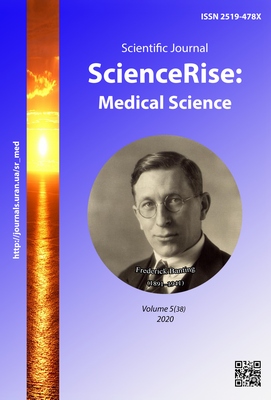Prognosis of difficult weaning from mechanical ventilation in children with acute respiratory failure
DOI:
https://doi.org/10.15587/2519-4798.2020.213053Keywords:
children, acute respiratory failure, prognosis of weaning from MVAbstract
The aim of this study was to determine the significance of factors such as transthyretin levels, right diaphragm thickening fraction, amplitude of left diaphragm dome movements, stroke volume index (SVI), cardiac index (CI), SpO2/FiO2 ratio and transthyretin/C-reactive protein in unsuccessful weaning from AV in children with various forms of ARF at the stage of weaning from mechanical ventilation (MV).
Materials and methods. We complete the prospective single-center cohort study and enrol 67 patients 1 month - 18 years old with hypoxemic and hypercapnic-hypoxemic acute respiratory failure (ARF). 46 of them need invasive mechanical ventilation (MV) for more than 3 days. We divide them into 1st group (n=35, they were successfully weaned) and 2nd group (n=11, they need reintubation and MV within the next 48 hours).
We performed ultrasound examination of diaphragm, prolonged non-invasive monitoring of hemodynamic parameters to determine SVI, CI, SpO2 with esCCO technology (estimated continuous cardiac output), NIHON COHDEN; determination of transthyretin (TTR) with G-Biosciences/Geno Technology, (USA) kit. Data were recorded on the first day of MV (d1), on 3rd, 5th, 7th day of treatment (d3, d5, d7). Logistic regression method was used to make a predictive model of the probability of unsuccessful weaning from MV.
Results. We have established (formula 1), that the risk of unsuccessful weaning from MV in patients with hypoxemic ARF increases with low values of transthyretin serum level, right hemidiaphragm thickening fraction, SVI and high CI.
R= -12,008 + 0,242*(TTR, ng/ml) + 1,720*(right hemidiaphragm thickening fraction, %) + 1,711*(SVI, ml/beat/m2) – 3,120*(СІ, l/min/m2) (1).
The risk of unsuccessful weaning from MV in patients with hypercapnic-hypoxemic ARF (formula 2) increases with low values of transthyretin serum level, amplitude of left hemidiaphragm movement, SVI, SpO2/FiO2 and transthyretin/C-reactive protein ratio.
R= - 42,233 + 0,389*(TTR, ng/ml) + 22,189*(amplitude of left hemidiaphragm movement, mm) + 1,120*(SpO2/FiO2) + 2,885*( SVI, ml/beat/m2) + 14,944*(TTR/CRP) (2).
Conclusions. The level of transthyretin and SVI in addition to the indicators of thickening fraction of right hemidiaphragm and CI in children with hypoxemic ARF and the amplitude of left hemidiaphragm movements, ratios SpO2/FiO2 and transthyretin/C-reactive protein in children with hypercapnic-hypoxemic ARF might affect the process of weaning from MV. Thus, acute malnutrition with diaphragmatic dysfunction and hyperdynamic type of blood circulation reduce the likelihood of successful weaning from MV and worsen clinical outcome in children with different types of ARF
References
- Yoshida, T., Uchiyama, A., Matsuura, N., Mashimo, T., Fujino, Y. (2012). Spontaneous breathing during lung-protective ventilation in an experimental acute lung injury model: high transpulmonary pressure associated with strong spontaneous breathing effort may worsen lung injury. Critical Care Medicine, 40 (5), 1578–1585. doi: http://doi.org/10.1097/ccm.0b013e3182451c40
- Koh, J. W. J. C., Wong, J. J.-M., Sultana, R., Wong, P. P. C., Mok, Y. H., Lee, J. H. (2017). Risk factors for mortality in children with pneumonia admitted to the pediatric intensive care unit. Pediatric Pulmonology, 52 (8), 1076–1084. doi: http://doi.org/10.1002/ppul.23702
- Abdo, M., Talat, M., Zamzam, S. (2014). Difficult weaning from mechanical ventilation in the pediatric ICU. Ain-Shams Journal of Anaesthesiology, 7 (1), 76–79. doi: http://doi.org/10.4103/1687-7934.128423
- Nitta, K., Okamoto, K., Imamura, H., Mochizuki, K., Takayama, H., Kamijo, H. et. al. (2019). A comprehensive protocol for ventilator weaning and extubation: a prospective observational study. Journal of Intensive Care, 7 (1). doi: http://doi.org/10.1186/s40560-019-0402-4
- Turton, P., ALAidarous, S., Welters, I. (2019). A narrative review of diaphragm ultrasound to predict weaning from mechanical ventilation: where are we and where are we heading? The Ultrasound Journal, 11 (1). doi: http://doi.org/10.1186/s13089-019-0117-8
- Porhomayon, J., Papadakos, P., Nader, N. D. (2012). Failed Weaning from Mechanical Ventilation and Cardiac Dysfunction. Critical Care Research and Practice, 2012, 1–6. doi: http://doi.org/10.1155/2012/173527
- Boles, J.-M., Bion, J., Connors, A., Herridge, M., Marsh, B., Melot, C. et. al. (2007). Weaning from mechanical ventilation. European Respiratory Journal, 29 (5), 1033–1056. doi: http://doi.org/10.1183/09031936.00010206
- Porhomayon, J., Papadakos, P., Nader, N. D. (2012). Failed Weaning from Mechanical Ventilation and Cardiac Dysfunction. Critical Care Research and Practice, 2012, 1–6. doi: http://doi.org/10.1155/2012/173527
- Routsi, C., Stanopoulos, I., Kokkoris, S., Sideris, A., Zakynthinos, S. (2019). Weaning failure of cardiovascular origin: how to suspect, detect and treat – a review of the literature. Annals of Intensive Care, 9 (1). doi: http://doi.org/10.1186/s13613-019-0481-3
- Yi, L., Liu, Z., Qiao, L., Wan, C., Mu, D. (2017). Does stroke volume variation predict fluid responsiveness in children: A systematic review and meta-analysis. PLOS ONE, 12 (5), e0177590. doi: http://doi.org/10.1371/journal.pone.0177590
- Lee, E.-P., Hsia, S.-H., Hsiao, H.-F., Chen, M.-C., Lin, J.-J., Chan, O.-W. et. al. (2017). Evaluation of diaphragmatic function in mechanically ventilated children: An ultrasound study. PLOS ONE, 12 (8), e0183560. doi: http://doi.org/10.1371/journal.pone.0183560
Downloads
Published
How to Cite
Issue
Section
License
Copyright (c) 2020 Olha Filyk

This work is licensed under a Creative Commons Attribution 4.0 International License.
Our journal abides by the Creative Commons CC BY copyright rights and permissions for open access journals.
Authors, who are published in this journal, agree to the following conditions:
1. The authors reserve the right to authorship of the work and pass the first publication right of this work to the journal under the terms of a Creative Commons CC BY, which allows others to freely distribute the published research with the obligatory reference to the authors of the original work and the first publication of the work in this journal.
2. The authors have the right to conclude separate supplement agreements that relate to non-exclusive work distribution in the form in which it has been published by the journal (for example, to upload the work to the online storage of the journal or publish it as part of a monograph), provided that the reference to the first publication of the work in this journal is included.









